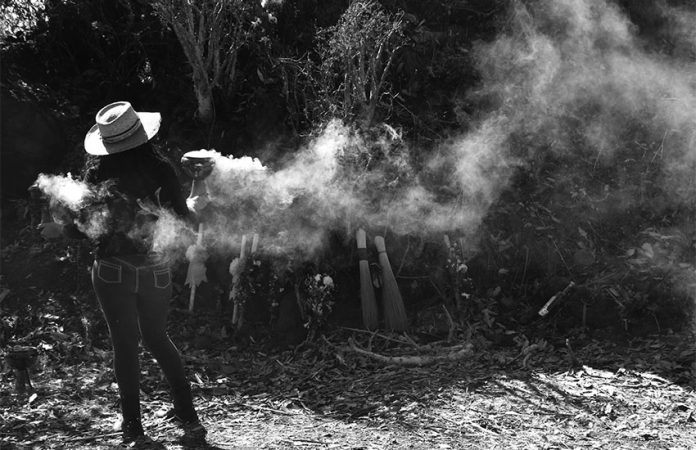All it took was one small incident to completely change my worldview.
One morning about a year ago, I was showering with Martha, my novia (don’t worry — the rest of this article is rated PG). I had my back to the shower curtain when she happened to glance over my shoulder.
“Look,” she said. “The shower curtain fell.”
I turned and saw that part of the curtain had become unhooked. Five or six shower curtain rings were gently swaying.
“That’s weird,” I said and rehooked the curtain, thinking nothing more about it.
We went out for breakfast, and it was then that I realized something wasn’t quite right about what I’d seen in the shower.
I asked Martha what she had seen, and she said she happened to be looking at the curtain and saw it fall.
“Wait a minute,” I said. “There’s no way that curtain could come unhooked without someone doing it, and neither of us did.”
It was the first of several incidents to come that defy a logical explanation.
At the time of this incident, I’d been working on a project photographing graniceros, traditional Mexican shamans who conduct five ceremonies a year to control the weather.
The first, the Blessing of the Seeds, is typically on February 2, the beginning of the agricultural cycle. After that comes the Petition for Rain in May, the Canicula in July and the Fiesta of the First Corn in August. The last is the Ceremony of Gratitude in November.
The ceremonies are held near Popocatépetl, an active volcano, and Iztaccíhuatl, a nearby extinct volcano. In the indigenous worldview, these two volcanoes are gods.
Before entering the place where the ceremony was to happen, each participant is sprayed with a liquid called “flower water” to protect us from malos aires — bad spirits. Participants kneel before an altar and say their name and where they’re from. According to Gerardo, one of the graniceros, we do this “because it is their house.”
During the ceremonies, I doused myself with flower water, introduced myself to the spirits and underwent cleansings, out of respect for the graniceros and their beliefs. My attitude when I first started documenting — and participating in — these ceremonies was that I believed that they believed; I didn’t.
Then things started happening in my home.
Books that were on a bookshelf ended up on the floor when they couldn’t have gotten there on their own. Curtains that I tied securely came untied after I left the room. No one else was around.
On at least three occasions, I was in my office when Martha walked in and asked, “What do you want?”
I told her I didn’t want anything.
“Then why did you call me?” she asked.
I hadn’t.
When something unusual happened, I first looked for a logical, non-supernatural explanation or blamed my cat. When neither of them worked, I had to accept the fact that something was going on that I didn’t understand.
I asked Gerardo about these incidents, and he said they were caused by aires, spirits that exist everywhere. He said they weren’t evil, that they were childlike spirits that aided Tlaloc, the god of rain. They liked to play games, he said. They could move things and, yes, call out my name.
Because I’d been attending ceremonies, I’d either awakened or attracted a spirit, he said.
I’ll always remember his answer when I asked him for a clearer explanation of who or what they are.
“They are,” he said, “immortales.”
He suggested making a small altar in my home with flowers, water and tobacco. I have.
At the end of an interview I conducted with Dr. Mauricio Ramsés Hernández Lucas, who has studied and written extensively about graniceros, I worked up the courage to tell him about the things happening in my house. I fully expected him to tell me it was my imagination or that there were logical explanations or that I needed professional help.
Instead, he smiled a little and nodded his head. He said it was nothing unusual and was completely expected because I’d participated in the ceremonies. He thought that a spirit had attached itself to me.
He said he’d experienced similar events and, in typical Mexican fashion, added, “No pasa nada.” Nothing will happen; don’t worry about it.
In addition to granicero ceremonies, I’ve attended dozens of other pre-Hispanic events that have caused me to think differently about religious or spiritual beliefs. While items placed in front of indigenous altars are called “offerings,” the same items placed on altars in churches and temples are called “decorations.” I’ve come to believe that they’re offerings.
I find it curious how every reported appearance of the Virgin Mary in Mexico has occurred on a site where an Indigenous goddess had been worshipped. And how every miraculous appearance of a Catholic cross happened in a place where an Indigenous god had been worshipped.
I now believe that while the names change, the god, or whatever you want to call it, stays the same.
Mexico is a land of mystery, one where indigenous cultures and traditions are still vibrantly alive. It’s a place where spirits exist and unexplainable things happen — México profundo. During my four years living here, I’ve learned to be open to things, to accept things I can’t understand or explain: things like aires and the gods that live in the mountains.
A shower curtain falling isn’t exactly a St. Paul-on-the-road-to-Damascus moment, but it’s had the same effect: I didn’t believe before; I have to believe now — I have no choice.
I don’t understand, but I believe.
Joseph Sorrentino, a writer, photographer and author of the book San Gregorio Atlapulco: Cosmvisiones and of Stinky Island Tales: Some Stories from an Italian-American Childhood, is a regular contributor to Mexico News Daily. More examples of his photographs and links to other articles may be found at www.sorrentinophotography.com He currently lives in Chipilo, Puebla.
